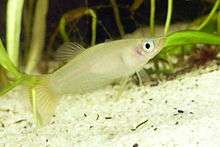Alfaro cultratus
Alfaro cultratus, the knife livebearer, is a species of tropical freshwater fish from the family Poeciliidae. It hails from Central America and is often kept in home aquaria.
| Alfaro cultratus | |
|---|---|
 | |
| Scientific classification | |
| Kingdom: | Animalia |
| Phylum: | Chordata |
| Class: | Actinopterygii |
| Order: | Cyprinodontiformes |
| Family: | Poeciliidae |
| Genus: | Alfaro |
| Species: | A. cultratus |
| Binomial name | |
| Alfaro cultratus (Regan, 1908) | |
| Synonyms[1] | |
| |
Names
The scientific name of the species comes from the Costa Rican zoologist Anastasio Alfaro.[1] The vernacular name for Alfaro cultratus, knife livebearer, comes from the two knife-shaped rows of scales near the tail on the lower end of the fish.[2] It is known as olomina in Costa Rica,[3] as are many similar fish.[4]
Description
It has two knife-shaped rows of scales on the lower edge of its caudal peduncle. Its body is overall olive-gray, paler on the belly, while the flanks have blueish or green hues. The fins are transparent, but the caudal fin develops a dark edging as the fish ages.[2] Maximum recorded length of the knife livebearer is 7.5 cm for males and 8.0 cm for females.[1]
Distribution and habitat
The knife livebearer is native to the Central American countries of Costa Rica, Panama and Nicaragua.[1] It is usually found in small groups in slow to moderately fast flowing creeks and ditches and in the shorelines of large rivers,[5] but it is a powerful swimmer[2] and has also been recorded inhabiting a fast flowing stream in a rainforest.[6]
It is the most common poeciliid in the rivers of the Maquenque National Wildlife Refuge in Costa Rica.[3]
Ecology
Alfaro cultratus is insectivorous, taking aquatic insects as juveniles and moving onto terrestrial insects in adulthood.[5]
Like most American poeciliids, the knife livebearers reproduce ovoviviparously. After a gestation period of 24 days, the female gives birth to 10 to 30 young, seldom more.[1] For a livebearer, the gestation period is relatively short and the brood size small.[2] The fry reach sexual maturity within six months.[1]
Fishkeeping
Alfaro cultratus is one of numerous livebearers popular in the fishkeeping hobby. It requires a temperature of 24 °C (75 °F) to 28 °C (82 °F). The fish is intolerant of stagnant water, being susceptible to bacterial infections, making it necessary to change about 30% of the aquarium water twice a month. Aquatic plants help reduce its natural skittishness.[2]
The knife livebearers are best kept in a single species aquarium. The adults should be fed small live food such as daphnia, but will also take flake food. The fry can be fed brine shrimp nauplii.[2]
References
- Froese, Rainer and Pauly, Daniel, eds. (2019). "Alfaro cultratus" in FishBase. August 2019 version.
- Alderton, David (2012). Livebearers: Understanding Guppies, Mollies, Swordtails and Others. i5 Publishing. p. 136. ISBN 1620080060.
- Mauricio Salas Varga (July 2008). Humedales de Ramsar (FIR) – Versión 2006-2008 (PDF) (Report) (in Spanish). Centro Científico Tropical. p. 20. Retrieved 30 August 2019.
- Mauricio Salas Varga (2009). Humedales de Ramsar (FIR) – Anexo #2 Biodiversidad 2009 (PDF) (Report) (in Spanish). Centro Científico Tropical. p. 4. Retrieved 30 August 2019.
- Bussing, William A. (1998). Peces de las aguas continentales de Costa Rica. Editorial de la Universidad de Costa Rica (in Spanish) (2nd ed.). University of Costa Rica. p. 468.
- Wischnath, Lothar (1998). Atlas of livebearers of the world. Editorial de la Universidad de Costa Rica (2nd ed.). T.F.H. Publications, Inc. p. 336.